
Chaco Culture National Historical Park
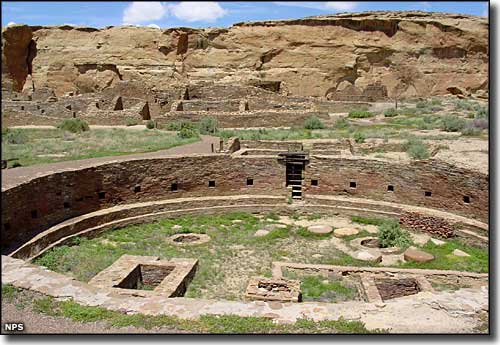
The main kiva and pueblo at Chetro Ketl in Chaco Canyon
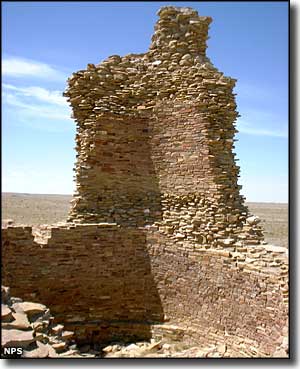
Chaco was the center of trade, religious ceremony and governmental administration for the Four Corners area from about 850 CE to about 1250 CE. These were the Ancestral Puebloans and their expression of civilization here was marked by large pre-planned masonry constructions, advanced geometries, explicit astronomical alignments, fine engineering and developed landscaping that added up to an impressive urban center of spectacular public architecture.
Looking at Chaco Canyon today, it's hard to believe an urban center the size of this one could have grown and flourished in this high desert landscape with short growing seasons and marginal rainfall. Obviously, the climate had to be significantly wetter from at least the mid 800's to about 1250 CE. Several of the Great Houses were built in the late 800's and early 900's, built to exacting astronomical orientations and architectural standards. The builders used masonry techniques unique for the time, constructing multi-storied edifices with hundreds of rooms each. Each was built to a pre-specified plan in contrast to the previously-normal method of adding extra rooms as they were needed. Some of these buildings had to take decades to build, some might have taken a century or more. Each one, though, is definitely recognizable as a representative of Chacoan architecture.
The landscape of the whole of Chaco Canyon was taken into account for the whole of the constructon here. Communication between the Great Houses, pueblos and kivas was by line of sight. Each construction was placed explicitly among sacred mesas, shrines and mountains, surrounded by communication features, astronomical markers, water control devices and formal earthen mounds used for ceremonial purposes. This was the Ancestral Puebloan version of "Feng Shui" on a colossal scale.
Chaco Canyon was the economic, administrative and ceremonial center of a distinctive widespread civilization. Impressive roads traveled cross country from Chaco in all directions, connecting with more than 150 other Great Houses spread around the Four Corners region. This network of roads is overgrown and eroded to the eyes of Earthbound travelers now but is still visible to anyone looking down from space. Chaco Canyon was the center of a trading network that trafficked in turquoise, macaws, sea shells, copper bells and other commodities, many from thousands of miles away.
Construction in the canyon slowed in the 1100's and ground to a halt in the early 1200's. Chaco Canyon was essentially abandoned by 1250 CE as the population had grown too large to be supported in the changing climate conditions. Many of the residents moved north to the new pueblos being built in the area of Aztec, Mesa Verde and the Chuska Mountains while others moved downstream to the pueblos along the Rio Grande. Folks slowly shifted away from the long-established Chacoan ways and their religions and spirituality evolved. Many tribes and clans in the Southwest still trace their ancestries back to Chaco, some return regularly to carry out ceremonies to honor their ancestors in what is still a very sacred place.
The earliest known map of the area was drawn in 1776 by a Spanish cartographer named Bernardo de Miera y Pacheco. Chaco Canyon had already been abandoned for more than 500 years by then. I would imagine those early Spanish explorers were surprised to stumble on something as large and magnificent as Chaco must have looked more than 230 years ago.
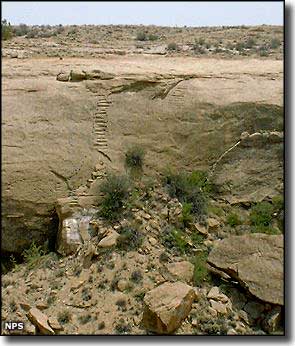
Today, most folks begin their visit to Chaco Culture National Historical Park at the Visitor Center (museum, theater, information desk, gift shop, bookstore, restrooms). From the Visitor Center, there's a 9-mile paved loop road that accesses the parking areas for six major sites in the valley (Hungo Pavi, Una Vida, Pueblo del Arroyo, Pueblo Bonito, Casa Rinconada and Chetro Ketl). There are well-marked self-guided trails from each parking area to and through each set of ruins. There are also four marked back country trails that access some of the more remote sites and features, including stairways, petroglyphs, ancient roads and spectacular valley overlooks. The trails are open from sunrise to sunset but you'll need a free back country permit before hiking and camping is not allowed in the back country, camping is allowed only at Gallo Campground.
To get there: The primary route to Chaco Culture National Historical Park is via US Highway 550. Turn south off US 550 about 3 miles southeast of the Nageezi Trading Post (at mile post 112.5) on County Road 7900. From that turnoff, there's eight miles of pavement (CR 7900) and 13 miles of packed dirt and gravel road (CR 7950) to the Chaco Culture National Historical Park Visitor Center. A word of warning: Many of these modern GPS mapping/guide services may direct you to take other roads in the area. Many of those other roads eat typical passenger cars as a snack before breakfast. CR 7950 is maintained regularly and is the most direct route to where you want to go.
There are also roads that reach Chaco Canyon from the south: Warning! The best roads are rough to impassable, the others are beyond ridiculous, unless you happen to be driving a rock crawler and it's been dry out for days...
The park is open from sunrise to sunset every day. The visitor center is open from 8 am to 5 pm daily except Thanksgiving, Christmas Day and New Years Day. The park entrance fee is $8 per single passenger vehicle, good for seven days from date of purchase. Camping at Gallo Campground is best rated as "slightly developed" (meaning: tent pads, picnic tables and fire pits or charcoal grills). There are no hookups of any kind at any of the 49 regular and 2 group sites. There is also no shade (although I do remember there being one tree that cast a bit of shade over one campsite early in the morning). The stay limit is seven days and vehicles over 35' don't fit. Cost: $10 per site per night for a max of six campers, two tents and two vehicles. Bring your own firewood or charcoal, there's none available at the park and gathering firewood is not allowed. Same as there's no food, gasoline or ice available at the park. There is drinking water available at the Visitor Center, you'll find telephones there, too. There are flush toilets in the campground but no showers. Site #16 and both restrooms are universally accessible.
Chaco Culture National Historical Park was declared a UNESCO World Heritage Site on December 8, 1987, joining a select list of protected areas around the globe "whose outstanding natural and cultural resources form the common inheritance of all mankind..."
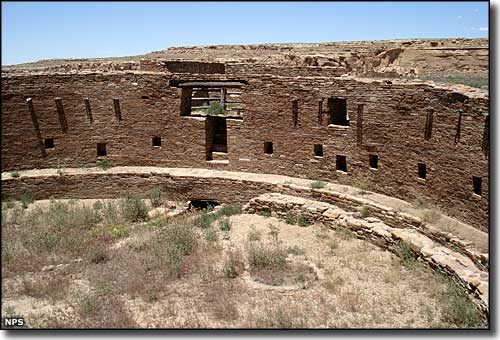
The Grand Kiva at Casa Rinconada
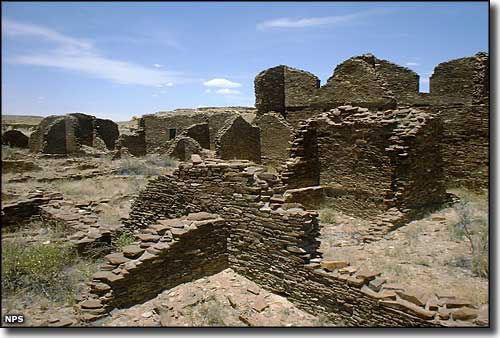
Kin Bineola
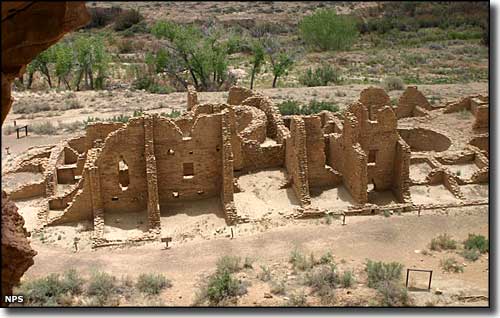
Kin Kletso
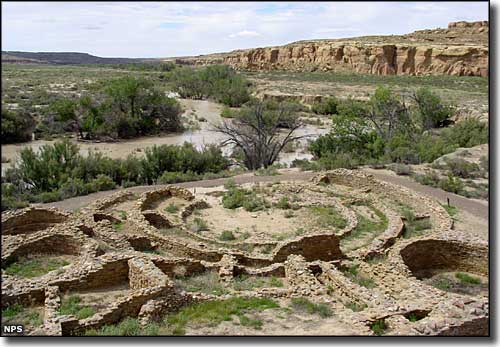
Pueblo del Arroyo

Map of Chaco Culture National Historical Park, click on the map to see a larger version
